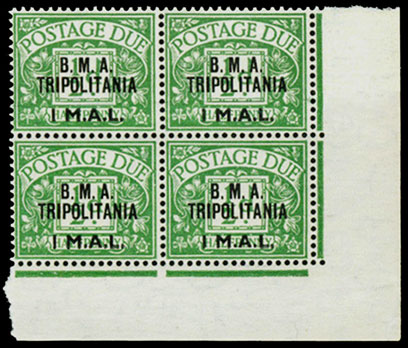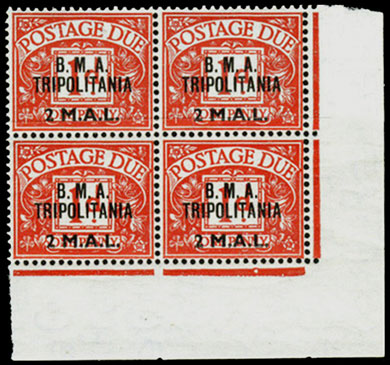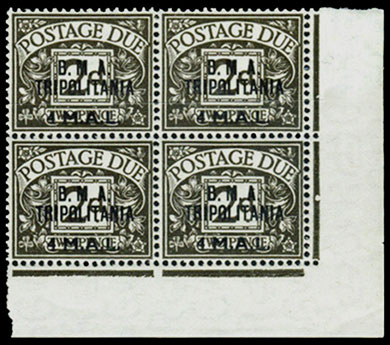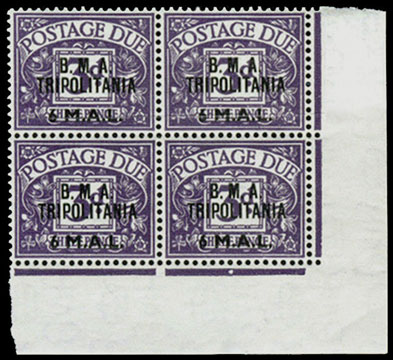Letterpress
Plates were allocated current numbers (sequence numbers) by the Royal Mint with the Postage Dues having their own numbering sequence, running from 1 to 49. The first plate for ½d Postage Dues, for example, was number 16. A repetition number specified a sequence within duty value; thus, the ½d plate numbering begins: 16/1, 17/2, 18/3, etc. The current and repetition numbers were sometimes swapped, for example 1/16.
Initially, plates had two panes of 12×10 stamps separated by a central margin of ladder bars.
Computer generated image, click to enlarge.
The Post Office, at the same time as changing printing contractor from Harrison to Waterlow, changed the layout of printing plates to economise on the use of paper. The central margin was removed, and an arrow piece was inserted in each side flange to denote the position of the half sheet. The Mint converted 29 plates by the end of 1923, an additional 141 plates were converted during 1924, and the task was completed during 1925 with 63 more plates (for a total of 233 plates, of which 40 were Postage Dues).
Computer generated image, click to enlarge.
For most denominations, there was one Master Plate and a number of Working Plates moulded from the Master. A few plates, e.g. the 1½d Postage Due, were struck directly on leads without the use of a Master Plate. The dates listed below are when the Working Plates were placed in stock, i.e. received by the Post Office Stamping Department from the Mint.
| 16/1 | 18 Mar 1914 | ✓ |
| 17/2 † | 11 June 1914 | |
| 18/3 | 25 Mar 1914 | ✓ |
| 19/4 | 20 Apr 1914 | ✓ |
| 20/5 | 7 Oct 1915 | |
| 21/6 | 7 Jan 1915 | ✓ |
| 13/1 | 13 Mar 1914 | ✓ |
| 14/2 | defective* | ✗ |
| 15/3 | 20 Mar 1914 | ✓ |
| 22/4 | 16 Apr 1914 | |
| 23/5 | 29 May 1914 | |
| 24/6 | 7 Jan 1915 | |
| 25/7 | 7 Dec 1917 |
| 41/1 | 23 Sept 1922 | ✓ |
| 42/2 | — | ✗ |
| 43/3 | — | ✗ |
| 1/1 ‡ | 4 Feb 1914 | ✓ |
| 2/2 | defective* | ✗ |
| 3/3 | 14 Feb 1914 | ✓ |
| 4/4 | 4 Mar 1914 | ✓ |
| 5/5 | 28 May 1914 | |
| 6/6 | 23 Jan 1915 | |
| 7/7 | 15 Sept 1915 |
| 32/1 | 27 May 1918 | ✓ |
| 33/2 | 29 May 1918 | ✓ |
| 34/3 | 31 Aug 1926 | ✓ |
| 35/1 | 21 Oct 1920 | ✓ |
| 36/2 | 30 Oct 1920 | ✓ |
| 37/3 | 4 Feb 1921 | |
| 38/4 | 14 Feb 1921 | |
| 39/5 | 10 June 1921 | |
| 40/6 | — | ✗ |
| 8/1 | 11 Mar 1914 | ✓ |
| 9/2 | 12 Mar 1914 | ✓ |
| 10/3 | defective* | ✗ |
| 11/4 | 4 Apr 1914 | |
| 12/5 | 21 May 1914 | |
| 26/6 | 23 Jan 1915 | |
| 27/7 | — | ✗ |
| 46/1 | 16 Oct 1961 | ✓ |
| 49/1 | 18 Sept 1964 | ✓ |
| 28/1 | defective* | ✗ |
| 29/2 § | defective* | ✗ |
| 30/3 | 13 May 1915 | ✓ |
| 31/4 | 4 June 1915 | ✓ |
| 44/1 | 18 June 1924 | ✓ |
| 45/1 | 4 Mar 1955 | ✓ |
| 47/1 | 21 Mar 1963 | ✓ |
| 48/1 | 21 Mar 1963 | ✓ |
* defective plate, destroyed on 3 Feb 1919
† plate 17/2 was used in 1923-24 for 2/6 colour trials
‡ plate 1/1 was used in 1914 for the initial colour trials
§ four “heads” taken from plate 29/2 were mounted for 1s colour trials
✓ registration sheet held at the Postal Museum
✗ plate was not converted to Waterlow format
Plates remaining in stock after decimalisation were destroyed on 4 Oct 1974.
There are a handful of plating aids:
Plate 13/1 – small dent to the rule left of 12/1.
Plate 15/3 – possible printers mark in rule below 12/1 (1934 onwards).
Plate 16/1 – beveled margin rule below 12/1.
Plate 18/3 – dent to the rule below 12/2 (1926 onwards).
Plate 31/4 – apostrophe between A&G row 12/1.
Plate 33/2 – beveled margin rule below 12/3.
Plate 35/1 – tiny nick in the rule left of 12/1.
Plate 44/1 – nick in margin rule below 12/2.
Click the images to enlarge.
Printer’s plate markings may be found below and to the right of 12/20.
Click the images to enlarge.
Photogravure
1968-69 — printed in photogravure and perforated Type A(T) with a two-row comb.
Computer generated image, click to enlarge.
| 1 no dot | 28 Jan 1969 | ✓ |
| 1 no dot | 4 Oct 1968 | ✓ |
Decimal Issues
1970 — printed in gravure and perforated Type A(T) with a two-row comb.
Computer generated image, click to enlarge.
1982 — printed on a Chambon press and perforated in the web Type RE with a two-row comb.
Computer generated image, click to enlarge.
1994 — printed in lithography and perforated Type L(P) with a single-row comb.
Double panes were separated into two post office sheets; hence, no gutter pairs.
Computer generated image, click to enlarge.

















